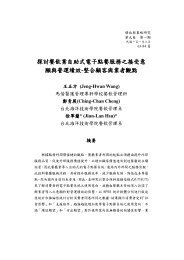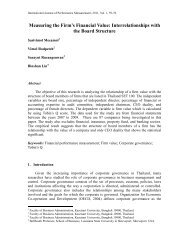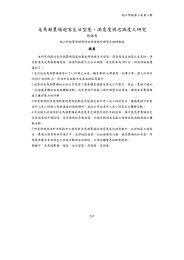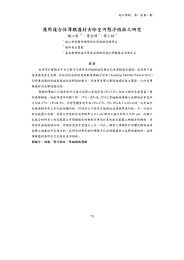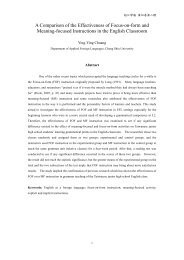ç®é - ç 究ç¼å±è - 稻æ±ç§ææ¨ç®¡çå¸é¢
ç®é - ç 究ç¼å±è - 稻æ±ç§ææ¨ç®¡çå¸é¢
ç®é - ç 究ç¼å±è - 稻æ±ç§ææ¨ç®¡çå¸é¢
You also want an ePaper? Increase the reach of your titles
YUMPU automatically turns print PDFs into web optimized ePapers that Google loves.
稻 江 學 報 第 五 卷 第 一 期<br />
Figure 3. Google Docs Interface.<br />
Moreover, Google Docs benefit some older adult learners who may not think as nimbly as other classmates,<br />
thereby avoiding the difficulty of slower learners easily falling behind during conventional class discussions.<br />
Blog<br />
Other instructional strategies related to Web 2.0 are also effective for achieving student understanding of the<br />
subjects they study in their classes. The blog is a very popular web application program in many different countries.<br />
For example, in Asian countries, such as Japan, Korea, and Taiwan, most school students have already configured<br />
their own personal blogs and the blog program represents a significant event in their social activities. Paquet (2003)<br />
refers to the term “blog,” initiated by Barger in 1997, as “a log of the web” — or Weblog. Duffy (2007, p.4)<br />
suggested that putting it “in its simplest form it is a website with dated entries, presented in reverse chronological<br />
order and published on the Internet.” The blog is an effective method to make students familiar with their educators.<br />
Instructors can write contents related to their everyday lives and post pictures, and also recommend short films that<br />
are of benefit to learners. In addition, blog can attract learners’ attentions and create positive relationships among<br />
instructors and learners.<br />
Within the structure of a blog, students can demonstrate critical thinking, take creative risks, and make use of<br />
language and design elements. In doing so, the students acquire creative, critical, communicative, and collaborative<br />
skills that may be useful to them in both scholarly and professional contexts (Duffy & Bruns, 2006).<br />
Methodology<br />
Moore and Kearsley (1996) mentioned that students often continue choosing distance learning courses after<br />
they successfully finish one on-line course and are satisfied. Hence, the research investigated older adults’<br />
satisfaction with Web-based learning courses at a continue learning institute which involved Web 2.0 collaborative<br />
learning environment, Blackboard system. Participants were over age 60. The purpose of this study was to identify<br />
perceived variables related to older adult learners’ satisfaction with Web-based learning courses which adopted Web<br />
2.0 technology. The research used a survey questionnaire to collect data from older adult learners via interview. In the<br />
first part of this questionnaire, the research developed four scales: age, marital status, educational background, and<br />
gender. These demographic characteristics can be explanatory variables in the regression analysis.<br />
In the second part of the survey, the study adopted the distance learning survey developed which included 21<br />
items to examine elder learners who are involved in Web-based courses. The survey was developed based on distance<br />
learners’ perception of distance learning environment theory. In this study, the researcher analyzed the collected and<br />
coded data by using the Statistical Package Social Sciences (SPSS) for windows software application. ANOVA and<br />
Pearson correlation coefficient analysis were used to examine the data.<br />
282



